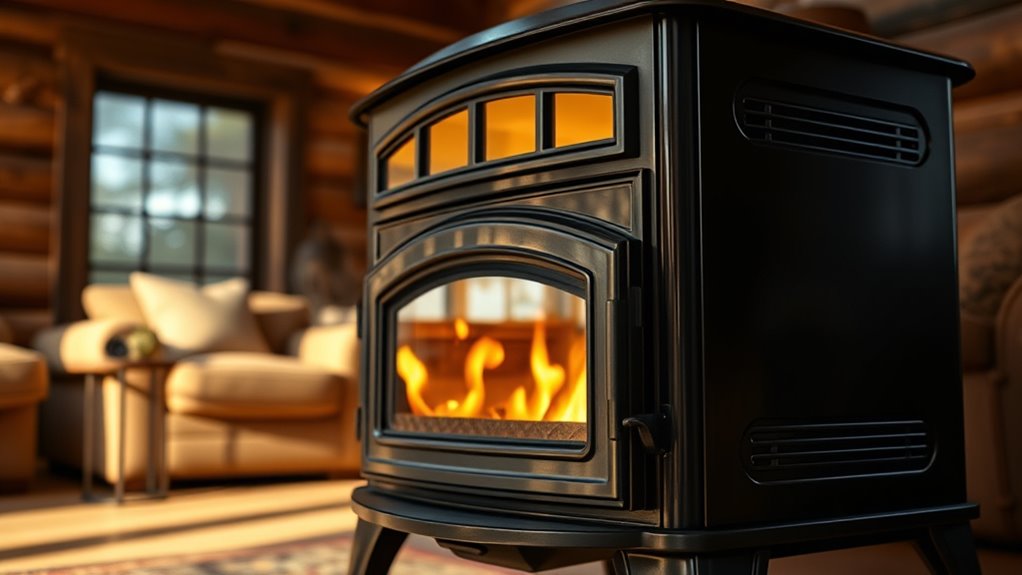To find the right size of wood stove for your home, measure your space in square footage and consider insulation and climate—typically, you need about 20-30 BTUs per square foot. Make sure the stove’s BTU range matches your heating needs, and keep safety and efficiency in mind during installation. Properly sizing your stove helps keep your home warm without wasting fuel. Keep exploring to discover how to choose the perfect stove for your specific space.
Key Takeaways
- Measure your home’s square footage and consider insulation to estimate heating needs in BTUs.
- Typical wood stoves require about 20-30 BTUs per square foot for adequate warmth.
- Match the stove’s BTU capacity to your calculated heating requirements for efficiency.
- Choose a stove size that fits your space constraints and aligns with your heating goals.
- Ensure proper installation and regular maintenance to maximize safety and stove performance.

Choosing the right wood stove size for your home is essential to guarantee efficient heating without wasting fuel or causing discomfort. When selecting a stove, you need to consider the size of your space and how much heat it requires. An undersized stove won’t provide enough warmth, forcing you to run it constantly, which leads to increased fuel consumption and potential wear on the unit. Conversely, an oversized stove can overheat your living space, making it uncomfortable and wasting energy. To find the perfect fit, start by calculating the square footage of the area you want to heat. As a general rule, a typical wood stove requires about 20 to 30 BTUs per square foot, depending on your climate and home insulation. For example, a well-insulated 1,000-square-foot house might need a stove rated around 20,000 to 30,000 BTUs. Keep in mind that factors like ceiling height, window placement, and insulation quality affect heat requirements, so these numbers serve as a starting point rather than an exact solution.
Additionally, considering small wood stove options can help you identify models that match your heating needs and space constraints. Once you’ve determined the appropriate BTU range, it’s crucial to think about stove installation tips to guarantee safety and efficiency. Proper installation not only maximizes heat output but also makes fireplace maintenance easier and safer. Make sure the stove is placed on a non-combustible surface, away from walls or furniture, to prevent fire hazards. Adequate clearance space around the unit is essential for safe operation and easy access for cleaning or repairs. Installing a proper chimney or venting system is equally important; it ensures proper draft and prevents dangerous smoke buildup inside your home. Consulting with a professional installer can help you adhere to local codes and manufacturer guidelines, which is essential for safety and performance.
Choosing the right size also means considering your lifestyle and heating preferences. If you prefer to heat a single room or a small area, a smaller stove will suffice. For whole-home heating, a larger stove or multiple units might be necessary. Remember, regular fireplace maintenance is key to keeping your stove operating efficiently and safely. Regularly cleaning the chimney, inspecting seals, and checking for wear prolongs the lifespan of your stove and maintains ideal heat output. By selecting the right size based on your home’s specific needs and following stove installation tips, you guarantee your wood stove functions effectively, saving you money and providing consistent warmth for years to come.
Frequently Asked Questions
How Do I Calculate the Exact BTU Output Needed for My Home?
To calculate the exact BTU output needed, start by evaluating your home’s heat loss, which depends on factors like climate, window efficiency, and insulation levels. Measure your home’s square footage and consider insulation quality to estimate how much heat you lose during winter. Use this data to determine the BTU capacity required for your wood stove, ensuring it can adequately offset heat loss and keep your home comfortably warm.
Can I Use the Same Stove Size for a Two-Story House?
You can’t use the same stove size for a two-story house without adjustments. Studies show heating efficiency drops by up to 30% if the stove isn’t properly matched to your home’s size and layout. For stove installation, consider the heat distribution across floors, and follow maintenance tips to guarantee consistent performance. Upgrading your stove or adding a second unit might be necessary for even warmth and energy savings.
What Are the Safety Considerations for Different Stove Sizes?
You need to take into account fire risk and ventilation requirements for different stove sizes. A larger stove generates more heat, increasing fire risk if not properly installed or maintained. Make certain your home has adequate ventilation to prevent smoke buildup and carbon monoxide accumulation. Always follow manufacturer guidelines and local codes, and schedule professional inspections regularly. Proper safety measures minimize hazards and keep your home safe while enjoying the warmth of your wood stove.
How Does Insulation Affect the Size of Wood Stove Needed?
Imagine a cozy room wrapped in thick insulation, trapping heat like a warm hug. Insulation impact is significant — it enhances heat retention, so you can opt for a smaller stove. Without proper insulation, your space loses heat faster, requiring a larger stove to maintain comfort. As a result, better insulation reduces the size of the wood stove needed, helping you save energy and increase efficiency while keeping your home warm.
Are There Specific Stove Sizes Recommended for Small or Large Homes?
For small homes, a compact stove size works best, typically around 1,000 to 2,000 square feet. Large homes need a bigger stove size, often between 2,500 to 4,000 square feet, to guarantee sufficient heat distribution. You should consider your home’s insulation and layout, but generally, matching the stove size to your home size helps maintain comfort and efficiency. Always consult with a professional for precise recommendations.
Conclusion
Now that you know how to determine the right size wood stove for your home, the real question is—are you ready to make the switch? Choosing the perfect stove isn’t just about numbers; it’s about creating warmth and comfort that lasts all winter. Imagine cozy evenings by the fire, knowing you’ve made the right choice. But beware—pick the wrong size, and your comfort could quickly turn to frustration. So, what’s your next step?











